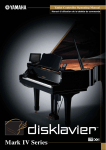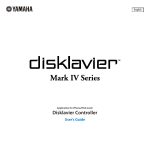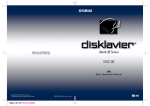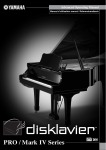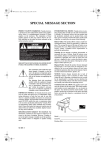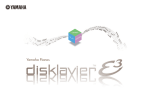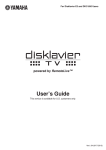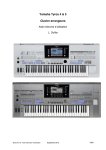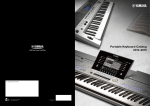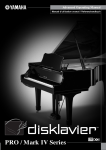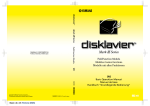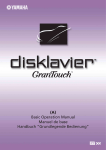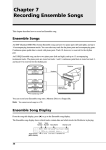Download Yamaha Mark IV Musical Instrument User Manual
Transcript
English Table of Contents Chapter 1 Getting Started Items Supplied with the Disklavier............................... 3 Names of Parts and Their Functions ............................ 4 Chapter 2 2 32 Adjusting the Volume Balance among the Keyboard Playing, Ensemble Sound, Software Playback, and Microphone’s Input............................................. 34 Troubleshooting 36 Copying Albums, Songs or the Entire Contents in a Source........................................................ 44 Deleting Albums, Songs and Play Lists ...................... 47 Rearranging the Order of Albums, Songs and Play Lists ..................................................... 49 Erasing the Data in a Floppy Disk ............................ 51 52 Changing the Picture in the Frame ........................... 55 Slide Show ........................................................... 57 Adding Images to the Picture Collection for the Frames in a Room (Background) ...................................... 58 Refreshing Contents in [From/To PC Folder] .............. 59 Function of the Configuration Bar Pairing the Tablet Controller and the Disklavier .......... 60 Restarting the Interface Screen ................................. 62 Adjusting the Volume of the Tablet Controller ............. 63 Chapter 8 Changing the Playback Tempo ................................ 24 Playing Back Songs in a Different Key (Transposition) ................................................... 25 Playing Back Only the Desired Piano Part ................. 26 Playing Back Songs with the Lyrics on the Screen....... 27 Changing the Background of the Lyric Screen ........... 28 Adjusting the Volume of the Microphone’s Input and the Depth of it’s Reverbration......................... 30 Other Features Key Prompt Display during SmartKey TM Playback ....... 52 Display during Recording ........................................ 52 Display during Playback of DisklavierRadio ............... 53 Display during Using the IDC Service........................ 53 Changing the Design of the Room (Background) ........ 54 Chapter 7 15 Creating a Song Library Basic Operation on the File Manager ....................... 36 Creating an Album in the Library ............................. 39 Renaming an Album, Song, or Play List ..................... 40 Creating a New Play List......................................... 41 Adding the Desired Song to Play List ........................ 43 Chapter 6 Turning the Disklavier Off (Standby Mode)................ 12 Shutting Down the Disklavier ................................... 13 Basic Piano Playing Playing the Acoustic Piano (Acoustic Mode)............... 32 Playing the Digital Piano (Quiet Mode) ..................... 32 Using Headphones (Headphone Mode) .................... 33 Chapter 5 8 Basic Playback Playing Back the Sample Songs in the Song Library .... 15 Adjusting the Overall Volume .................................. 18 Selecting a Song .................................................... 19 Searching Forward and Backward in a Song ............ 21 Selecting Directly the Different Song from the Current Album........................................ 22 Repeating Song Playback........................................ 23 Chapter 4 Preparing the Tablet Controller ................................... 6 Basic Operations Operating the Tablet Controller.................................. 8 Turning the Disklavier On .......................................... 9 Chapter 3 3 60 Adjusting the Brightness of the Touch Screen ............. 64 Setting the Time Zone............................................. 65 Other Buttons ........................................................ 66 67 Chapter 1 Getting Started Items Supplied with the Disklavier In addition to the items listed in “Items Supplied with the Disklavier” in “Advanced Operating Manual”, the items below are supplied with your Disklavier as well. • Tablet Controller (1) • Rechargeable batteries for Tablet Controller (1) • Cradle for Tablet Controller (1) • AC adaptor for Tablet Controller (1) • AC power cord for Tablet Controller (1) • Tablet Controller Operation manual (this book) (1) 3 Chapter 1: Getting Started Names of Parts and Their Functions Tablet Controller Left side Front Right side Bottom side Cradle 4 Chapter 1: Getting Started Tablet Controller Touch screen pg. 8 “Tapping with your fingers or the stylus pen” Outputs the sound of the Tablet Controller itself. CHARGE lamp Lights up orange when the Tablet Controller is being charged. Lights up green when the Tablet Controler is fully charged. Blinks red when the battery is almost empty. (power button)/ Power lamp Turns on the Tablet Controller. When this button is pressed while the Tablet Controller is on, the Power Management screen appears to shut down the system. / Lights up when the Tablet Controller is on. P button Shows the configuration bar. When this button is pressed while the configuration bar appears, the configuration bar is cleared. CF card slot For future use. Headphone jack For future use. Microphone jack For future use. USB port AC adaptor jack English Speaker For future use. Accepts the AC adaptor when the Tablet Controller is used without a cradle. Stylus pen For operating the touch screen. Pen holder Holds the stylus pen. Microphone For future use. Cradle interface Accepts the terminal on the cradle. PC card slot For future use. Cradle USB port AC adaptor jack Same as 9. Accepts the AC adaptor. 5 Chapter 1: Getting Started Preparing the Tablet Controller 1 Set up the cradle. 2 Put the rechargeable battery into the Tablet Controller. Battery lock Rechargeable battery Tip: Before removing the battery, move the battery lock to the direction of an arrow. 6 Battery lock Chapter 1: Getting Started 3 Open the cover of the cradle interface, and then set the Tablet Controller on the cradle. Charging starts and the charge lamp lights in orange. English Charge lamp Adjusting the angle of the cradle to your preference Loosen the two screws on the bottom of the base plate, adjust the angle, and then tighten the screws. 20º Base plate Bottom 7 Chapter 2 Basic Operations Before operating the Disklavier Be sure to set up the Disklavier and the Tablet Controller. ( Disklavier” in Advanced Operating Manual) pg. 11 “Setting Up the Convention In the following procedures, the buttons and controls are of the Tablet Controller unless otherwise noted. Operating the Tablet Controller You can operate the Tablet Controller by tapping items on the touch screen with your fingers. It is, however, recommended to use the supplied stylus pen to tap on a small point. Tapping with your fingers or the stylus pen Touch an item (application icon, button, control, etc.) on the touch screen once to execute its function. OR Stylus pen 8 Chapter 2: Basic Operations Turning the Disklavier On 2 Press the [ON] side of the [POWER] switch on the Monitor speakers. ( pg. 10 in “Advanced Operating Manual”) English 1 Confirm that the power cable of the Power Supply unit is connected to an AC wall outlet. Note: This step is necessary only for models supplied with the Monitor speakers. 3 Press the [ON] side of the [MAINS] switch on the Power Supply unit. ( pg. 5 in “Advanced Operating Manual”) 4 Press the [ON] side of the [MAINS] switch on the I/O Center. ( pg. 4 in “Advanced Operating Manual”) on the Media Center starts flashing green. Wait until on the Media Center stops flashing and dimly lights green, and then go to step 5. Note: It may take several minutes. Continue to next page . . . 9 Chapter 2: Basic Operations 5 Press (power button). The Tablet Controller is turned on and the Play screen appears. Function bar Play screen Note: This may take approximately two minutes. When turning the Disklavier back on after shutting down, be sure to wait 10 seconds before doing so. Tip: Pressing on the Media Center also turns the Disklavier on. In such a case, be sure to press (power button) to turn on the Tablet Controller as well. Note: After turning on the Tablet Controller for the first time, set up the Time Zone. For the procedure, 10 pg. 65 “Setting the Time Zone”. Chapter 2: Basic Operations Note: In case the Disklavier and the Tablet Controller cannot connect in wireless, the following display appears. English If this happens, either the Disklavier is turned off or the Tablet Controller is out of specified operation range. Note: It takes several minutes to turn on the Disklavier. So if you turn on the Tablet Controller and the Disklavier at the same time, the above display may appear for a while. Once the Disklavier is turned on, the above display will be changed to the standby display automatically. Standby display 11 Chapter 2: Basic Operations Turning the Disklavier Off (Standby Mode) After daily use, be sure to turn the Disklavier off by following the procedure below. In Standby mode, the piano is in effect turned off. However, electrically it is in a state in which a small quantity of power is being consumed. 1 Tap on 2 Tap on at the top of the Function bar. . on the media center lights dimly green. The following screen appears. Tap to restart the Disklavier. 3 12 Tap on . The Disklavier turns off. Chapter 2: Basic Operations Shutting Down the Disklavier 1 Tap on at the top of the Function bar. 2 Tap on . 3 Tap on English Before disconnecting the power cable from the AC wall outlet, be sure to shut down the Disklavier by following the procedure below. to shut down the Disklavier. on the media center goes out. Continue to next page . . . 13 Chapter 2: Basic Operations 4 Press (power button) to shut down the Tablet Controller. Power Management Power Button Pressed Enter Low Power Mode Tap to turn off the back light of the touch screen. Shutdown System Tap to clear the [Power Management] screen. Dismiss [Power Management] screen 5 Tap on Shutdown System to shut down the Tablet Controller. When turning the Disklavier back on, be sure to wait for 10 seconds before doing so. About the [MAINS] switches The [MAINS] switches (on both the Power Supply unit and the I/O Center) only need to be switched off when you are not going to use the Disklavier for a long period of time. It is effectively the same as disconnecting the power cable from the AC wall outlet. For daily use, you can keep the [MAINS] switches on, and turn the Disklavier on and off by following the procedure “Turning the Disklavier Off (Standby Mode)” ( pg. 12). 14 Chapter 3 Basic Playback Playing Back the Sample Songs in the Song Library 1 Turn the Disklavier on. ( Disklavier On”). pg. 9 “Turning the Function bar Play screen 2 Tap on on the Function bar in the Play screen. Continue to next page . . . 15 Chapter 3: Basic Playback 3 Tap on . Appears when there are more albums not shown in the screen. In such a case, move the slide bar to show the hidden albums. Albums contained in the [Pianosoft Library] Current page/Total page Tap to show the page containing the selected album. Sort buttons Appears when there are more albums not shown in Prev the screen. In such a case, tap on to show the previous album. Tap on Top to show the first album. 4 Appears when there are more albums not shown in the screen. In such a case, tap on to show the next album. Tap on to show the last album. Tap on the desired album. The frame of the selected album will be displayed in red. To select songs other than the first one in the album, tap on the desired album again, and then tap on the desired song. ( pg. 22) 16 Chapter 3: Basic Playback 5 Tap on . English Selected song and elapsed playing time Selected album and songs in the selected album 6 Tap on to start playback. will change to . To pause playback, tap on will change to . . To continue playback, tap on . To select the next song, tap on . To select the previous song, tap on . Tip: When is pressed while the last song of the album is played back, nothing happens. When is pressed while the first song of the album is played back, nothing happens. 17 Chapter 3: Basic Playback Adjusting the Overall Volume 1 Tap on on the right bottom of a screen. Volume knob 2 18 Drag the volume knob to adjust the volume. The volume knob will disappear if you don’t touch it for about 3 seconds. Chapter 3: Basic Playback Selecting a Song English 1 When you play back a song on a floppy disk, a CD, or a USB medium, load the relevant medium into their respective drives or port on the Media Center. ( pg. 2, 20 in “Advanced Operating Manual”) Function bar 2 Tap on on the Function bar. Continue to next page . . . 19 Chapter 3: Basic Playback 3 Tap on the desired source*. * In this manual, we call each removable medium (floppy disk, CD, and USB flash memory, etc.) and the internal song library as a “source”. Appears when there are more albums not shown in the screen. In such a case, move the slide bar to show the hidden albums. Selectable albums Selectable sources Current page/Total page Tap to show the page containing the selected album. Sort buttons Appears when there are more albums not shown in Prev the screen. In such a case, tap on to show the previous album. Tap on Top to show the first album. Tip: Pressing User PianoSoft CD FD Appears when there are more albums not shown in the screen. In such a case, tap on to show the next album. Tap on to show the last album. on the Media Center also select the source, and then starts playback. Tip: You can change the order of album on the screen by tapping on sort buttons. Album Number Album Name Updated Date Last Played Date Playcount 20 Chapter 3: Basic Playback 4 Tap on the desired album. The frame of the selected album will be displayed red. English To select songs other than the first one, tap on the desired album again, and then tap on the desired song. ( pg. 22) To play the selected album from its first song, see step 5 – 6 on “Playing Back the Sample Songs in the Song Library”. ( pg. 17) Searching Forward and Backward in a Song Forward/Backward button Playback status bar During playback or pausing, tap on / to locate the desired point. Tap on to start playback. During pausing, tap on / , and then tap on the same button again to pause at the desired point. Tip: Tapping on the desired point on the playback status bar starts playback from that point. 21 Chapter 3: Basic Playback Selecting Directly the Different Song from the Current Album You can specify the desired song to be played on the Play screen. 1 Playback the desired song. ( Song”). pg. 19 “Selecting a Selected album and songs in the selected album 2 Tap on nearby the song list. Song screen 3 22 Tap on the desired song, and then on The desired song is selected. . Chapter 3: Basic Playback Repeating Song Playback on the Function bar. English 1 Tap on The Ex-Ctrl (Extra control) bar appears on top center of the screen. [Repeat] control buttons Tip: You can move the Ex-ctrl bar wherever you want by dragging the right side of the bar. 2 Tap on 3 Tap on ALL: ONE: RND: OFF: / to select the desired repeat mode. Repeats all songs in the current album. Repeats the current song only. Repeats all songs in the current album in random order. Cancels repeat setting. after you finish setting to clear the bar. To cancel the repeat mode, select OFF in step 2. Tip: You can also clear the bar by tapping on again. 23 Chapter 3: Basic Playback Changing the Playback Tempo This feature is useful, for example, when you listen to a complicated piano part with more care in slow tempo, and also when you practice a difficult piano part in slow tempo. You can change the tempo while the song is played back or stopped. 1 Select the desired song. ( 2 Tap on pg. 19 “Selecting a Song”) on the Function bar. The Ex-Ctrl bar appears on top center of the screen. [Tempo] control buttons 3 Tap on [Tempo] / to adjust the value. To resume the original tempo, tap on [Tempo] . Tip: The value can be adjusted from –50% to +20% in 1% increments. 4 Tap on the bar. after you finish changing the tempo to clear Tip: You can also clear the bar by tapping on 24 . Chapter 3: Basic Playback Playing Back Songs in a Different Key (Transposition) English This feature is useful, for example, when you want to sing along in a key you are most comfortable with. 1 Select the desired song. ( 2 Tap on pg. 19 “Selecting a Song”) on the Function bar. The Ex-Ctrl bar appears on top center of the screen. [Transpose] control buttons 3 Tap on [Transpose] / to adjust the value. To cancel the transposition, tap on [Transpose] . Tip: The song can be temporarily transposed in half-step keys up or down two octaves (–24 to +24). Note: Care must be taken when transposing songs on CDs, as increasing or decreasing the transposition value too much may have an adverse effect on sound quality. 4 Tap on the bar. after you finish adjusting the value to clear Tip: You can also clear the bar by tapping on . 25 Chapter 3: Basic Playback Playing Back Only the Desired Piano Part This could be useful, for example, when you listen to one part with more care, and also when you practice only the left- or right-hand part while the Disklavier plays the other. 1 Select the desired song. ( 2 Tap on pg. 19 “Selecting a Song”) on the Function bar. The Ex-Ctrl bar appears on top center of the screen. [Part Cancel] control buttons 3 Tap on (left-hand part) / play/mute the part. (right-hand part) to Each time you tap on the part, its setting changes as follows showing the status with the color of the part icon: Ex.: The setting of the left-hand part Play 4 Tap on bar. after you finish selecting the part to clear the Tip: You can also clear the bar by tapping on 26 Mute . Chapter 3: Basic Playback Playing Back Songs with the Lyrics on the Screen English You can display the lyrics of songs played back. You can enjoy singing to your own Piano accompaniment and singing in Karaoke. 1 Tap on pg. 10). on the Function bar in the Play screen ( Lyric screen 2 Select the desired song. ( pg. 19 “Selecting a Song”) Continue to next page . . . 27 Chapter 3: Basic Playback 3 Tap on . Playback starts. The lyrics appear, and a color of the lyric changes as the song proceeds. Note: The lyrics are not shown when a song does not include the lyric’s data. Note: When a song does not include the lyric’s data, only a song title is shown. 4 Tap on to return to the Play screen. Note: For a user in North America, it is recommended to visit the website below to purchase songs with lyrics. http://www.yamahamusicsoft.com/ For a user living in an area other than in North America, it is recommended to consult your dealer. Changing the Background of the Lyric Screen You can change the background of the Lyric Screen depending on your mood. You can select an image from the category such as Nature, Flowers, Vacation, World, Textures, Holiday, and Romantic. 28 Chapter 3: Basic Playback 1 Tap on pg. 10). on the Function bar in the Play screen ( English Lyric screen 2 Tap on screen. on the left bottom of the Lyric [Background Select] screen Categories Images 3 4 Tap on the desired category, and then the image. Tap on to show the selected image as the background. The [Background Select] screen is cleared. 29 Chapter 3: Basic Playback Adjusting the Volume of the Microphone’s Input and the Depth of it’s Reverbration 1 Tap on pg. 10). on the Function bar in the Play screen ( Lyric screen 2 Tap on on the left bottom of the Lyric screen. [MIC Volume] bar [Reverb Type] buttons [Reverb Depth] bar 30 Chapter 3: Basic Playback 3 4 Tap on the desired point on the [MIC Volume] bar to adjust the volume of the Microphone’s input. 5 Tap on English Tap on the desired [Reverb Type] button, and then tap on the desired point on the [Reverb Depth] bar to adjust it’s depth. . The [MIC Setting] screen is cleared. 31 Chapter 4 Basic Piano Playing The Disklavier is a versatile instrument offering various functions that integrate innovative technologies, but let’s start with the most basic use of the piano: playing the keyboard. Playing the Acoustic Piano (Acoustic Mode) Play the keyboard as you would play any acoustic piano. You do not need to “turn the Disklavier on”. Playing the Digital Piano (Quiet Mode) Put the Disklavier in Quiet mode when you want to play the keyboard more quietly or more privately than on the acoustic piano. When Quiet Mode is activated, you are essentially playing the digital piano. Since the play sound is output through the Monitor speakers*, you can adjust the volume to your preference. 1 32 Turn the Disklavier on. ( Disklavier On”) pg. 9 “Turning the Chapter 4: Basic Piano Playing 2 Tap on on the left bottom of a screen to engage the Quiet Mode. The color of Tip: Pressing QUIET ). on the Media Center also engages the Quiet Mode. English 3 turns to blue ( Play the Disklavier. You will hear the sound of the digital piano through the Monitor speakers*. To disengage Quiet Mode, tap on The color of turns to red ( Tip: Pressing QUIET on left bottom of a screen. ). on the Media Center also inactivates the Quiet Mode. * Only for models supplied with the Monitor speakers. Using Headphones (Headphone Mode) 1 Turn the Disklavier on. ( Disklavier On”) pg. 9 “Turning the 2 Connect the supplied stereo headphones to the PHONES jack on the bottom of the Media Center. ( pg. 2 in “Advanced Operating Manual”) Continue to next page . . . 33 Chapter 4: Basic Piano Playing appears. Headphone mode indication 3 Play the Disklavier. The Acoustic mode is silenced and the digital piano sound is heard only from the connected headphones. Note: Two sets of headphones can be connected simultaneously. In this case, the two headphones should be of the same model. Adjusting the Volume Balance among the Keyboard Playing, Ensemble Sound, Software Playback, and Microphone’s Input 1 Tap on on the Function bar. Balance control display [Reset] button 34 Chapter 4: Basic Piano Playing Voice: Adjusts the volume of the digital piano sound* that you play on the Disklavier’s keyboard in Quiet/Headphone mode. ( pg. 32 “Playing the Digital Piano (Quiet Mode)”) * Note that this setting has no effect on the volume of the piano part pre-recorded on the software. English TG: Adjust the volume of the ensemble sound produced by the tone generator (TG) of the Disklavier. Audio: Adjusts the volume of the accompaniment or standard audio sound pre-recorded on the software (CDs). MIC: Adjusts the volume of the connected microphone. 2 3 Tap on the desired point on the volume bar of the desired sound to adjust its volume. To reset the setting, tap on Tap on . after you finish adjustment. Balance control display is cleared. Tip: You can also clear the Balance control display by tapping on . 35 Chapter 5 Creating a Song Library The following functions are useful for organizing the contents in the song libraries ([Pianosoft Library], [CD Library], [Download Library], [From/To PC Folder], and [User Library]) as well as the [Play Lists]. ( pg. 25 “Utilizing the Play Lists” in “Advanced Operating Manual”.) Basic Operation on the File Manager This section explains how to select an album, song, or play list. 36 1 Tap on 2 Tap on on the Function bar. File Manager screen appears. . Chapter 5: Creating a Song Library Finishes the file operation and returns to play screen. [Source] buttons [Album] list [Song] list English Information area Shows the selected source and details of the album or song. File operation buttons Once a source, album or song is selected, the available operation buttons are displayed. Starts playing the selected song. Tip: The File Manager screen shows the hierarchical directory structure of the Disklavier in an easy-to-understand appearance. You can intuitively select your desired song file or album. Source Song [FD] Album 01* Song 01 [CD] Album 01 Song 02 Album 02 Song 03 [Pianosoft Library] Album 01 Song 01 ····· ····· [User Library] ····· [USB Media] ····· Album [CD Library] [Play Lists] [From/To PC Folder] [Download Library] * The [FD] can contain only one album. Continue to next page . . . 37 Chapter 5: Creating a Song Library 3 Tap on the desired source. Ex: When [Pianosoft Library] is selected The background of [Source] become pink. The available operation appears. 4 The selected source become red. Tap on the desired album. Ex: When [PianoSoft Solo (Demo)] is selected The background of [Album] become pink. The available operation appears. 5 The selected album become red. Tap on the desired song. Ex: When [Black Key Etude in G flat from…] is selected The background of [Song] become pink. The available operation appears. 38 The selected song become red. Chapter 5: Creating a Song Library Creating an Album in the Library 2 Tap on pg. 36.) English 1 Select the desired source. ( . [New Album] screen 3 Tap on . Software keyboard 4 5 Tap on each character for the name of the new album. Note: The name must be within 64 characters. Tap on or . The software keyboard is cleared. Continue to next page . . . 39 Chapter 5: Creating a Song Library 6 7 Make sure the name is correct, and then tap on . Make sure [Complete] appears, and then tap on . Renaming an Album, Song, or Play List 1 Select the desired album, song, or play list. ( 2 Tap on pg. 36.) . The title of the selected album, song, or play list 3 Tap on . Software keyboard 40 Chapter 5: Creating a Song Library 4 5 Tap on each character for the name of the new album. 6 7 Make sure the name is correct, and then tap on . Note: The name must be within 64 characters. Tap on or . Make sure [Complete] appears, and then tap on English The software keyboard is cleared. . Creating a New Play List 1 Tap on ( pg. 36.) to select [Play Lists] as the source. 2 Tap on . [Create List] screen Continue to next page . . . 41 Chapter 5: Creating a Song Library 3 Tap on . Software keyboard 4 Tap on each character for the name of the new Play List. Note: The name must be within 64 characters. 42 5 Tap on or . 6 7 Make sure the name is correct, and then tap on . The software keyboard is cleared. Make sure [Complete] appears, and then tap on . Chapter 5: Creating a Song Library Adding the Desired Song to Play List 2 Tap on pg. 36.) English 1 Select the desired song. ( . The selected song [Add to PlayList] screen 3 4 5 Tap on , and then on the desired album as a destination. Tap on . Make sure [Complete] appears, and then tap on . 43 Chapter 5: Creating a Song Library Copying Albums, Songs or the Entire Contents in a Source This function is available except for [CD Library] and [Play Lists]. 1 Select the desired source, album or song. ( pg. 36.) 2 Tap on one of the desired file operation buttons below: : Selects the desired source to be copied : Select the desired album to be copied. : Select the desired song to be copied. Note: The available file operation buttons differ depending on the selected contents. The screen asking the destination appears. Ex.: When you tap on Selected source [Copy All] screen 44 Chapter 5: Creating a Song Library Ex.: When you tap on Selected album English [Copy Album] screen From now on, the procedure for coping a song is explained as an example. Ex.: When you tap on Selected song [Copy Song] screen 3 Tap on for destination source selection. [Select Source] screen 4 Tap on the destination source, and then on . [Select Source] screen is cleared. Continue to next page . . . 45 Chapter 5: Creating a Song Library 5 Tap on for destination album selection. [Select Album] screen 6 Tap on the destination album, and then on . [Select Album] screen is cleared. Destination source and album 7 8 Make sure the destination is correct, and then tap on . Make sure [Complete] appears, and then tap on . Note: The contents of a source other than CD cannot be copied to [CD Library]. 46 Chapter 5: Creating a Song Library Deleting Albums, Songs and Play Lists This function is available for all song libraries and [Play Lists]. 2 Tap on one of the desired file operation buttons below: English 1 Select the desired album, song, or play list. ( pg. 36.) : Delete the desired album : Delete the desired song : Delete the desired play list : Delete the desired song on the desired play list Ex.: When you tap on Selected album [Delete Album] screen Ex.: When you tap on Selected song [Delete Song] screen Continue to next page . . . 47 Chapter 5: Creating a Song Library Ex.: When you tap on Selected list [Delete List] screen Ex.: When you tap on Selected song [Clear Song] screen From now on, the procedure for deleting a song is explained as an example. 3 4 Make sure it is all right to delete it, and then tap on . Make sure [Complete] appears, and then tap on . Tip: Even if you delete a play list or song of the play list, the original song file cannot be deleted. 48 Chapter 5: Creating a Song Library Rearranging the Order of Albums, Songs and Play Lists English This function is available for all libraries and [Play Lists]. 1 Select the desired album, song or play list. ( pg. 36.) 2 Tap on one of the desired file operation buttons below: : Rearrange the order of albums : Rearrange the order of songs Ex.: When you tap on The selected album Rearranging buttons : Moves the album to the top of the source. :Moves the album downward. :Moves the album upward. : Moves the album to the end of the source. The destination [Sort Album] screen Continue to next page . . . 49 Chapter 5: Creating a Song Library Ex.: When you tap on The selected song Rearranging buttons : Moves the song to the top of the album. :Moves the song downward. :Moves the song upward. : Moves the song to the end of the album. The destination [Sort Song] screen 50 3 Tap on the rearranging button to move the selected album or song to the desired position, and then on . 4 Make sure [Complete] appears, and then tap on . Chapter 5: Creating a Song Library Erasing the Data in a Floppy Disk Make sure that the floppy disk is already formatted. 2 Tap on .( pg. 36.) English 1 Tap on . [Delete All] screen 3 Tap on . Note: Before tapping on , make sure it is all right to delete the contents. Note: DO NOT turn off the Disklavier or eject the floppy disk while the deletion is in progress. 4 Tap on . 51 Chapter 6 Other Features Key Prompt Display during SmartKeyTM Playback See pg. 35 “SmartKeyTM Playback” in “Advanced Operating Manual” for details. Key prompt is shown here. Display during Recording While recording, the following display appears. Note: While this screen appears, the Disklavier cannot be controlled by the Tablet Controller. 52 Chapter 6: Other Features Display during Playback of DisklavierRadio While playing back DisklavierRadio, the following display appears. English Channel name Volume knob ( pg. 18 “Adjusting the Overall Volume”) [Acoustic/Quiet] button ( pg. 32 “Playing the Digital Piano (Quiet Mode)”) Song title Display during Using the IDC Service While connecting the Disklavier to the IDC service, the following display appears and operations on the Tablet Controller are disabled.* * Except for during DisklavierRadio playback. 53 Chapter 6: Other Features Changing the Design of the Room (Background) You can change the design of the room (background) depending on your mood. 1 Tap on pg. 10). on the Function bar in the Play screen ( Every time you tap on it, the design of the room changes as follows: Room 1 Room 2 Room 3 Room 6 Room 5 Room 4 Tip: You can change a picture in a frame on the wall of the room. ( pg. 55 “Changing the Picture in the Frame”) Note: The design and the number of the Rooms are subject to change without notice. 54 Chapter 6: Other Features Changing the Picture in the Frame 1 Tap on 2 Tap on English You can change, move, zoom in or out the picture in the frame on the Room (background). (This is limited to only the design with a picture in a frame.) on the Function bar. . Frames Continue to next page . . . 55 Chapter 6: Other Features 3 Tap on the frame in which you want to change the picture. The inside of the frame turns to red. Saves the modification Zooms in or out Moves the picture upward, downward, right, and left Select the previous/next picture Current picture number Tip: You can add your favorite pictures as options for the frame. See pg. 58 for details. 4 5 Tap on the arrows or selected frame. Tap on / to modify the picture in the . The changed design is saved. Tip: When you want to change the picture in another room, tap on select the desired room, and then start from step 1. To return to the Play screen, tap on 56 . to Chapter 6: Other Features Slide Show You can enjoy a slide show using pictures saved in My Picture folder. ( English 1 pg. 58) Tap on a picture in a frame. Frame A picture saved in My Picture folder is displayed in turn in the whole area of a screen. 2 Tap on a screen during a slide show. The slide show finishes, and then the screen returns to the Play screen. 57 Chapter 6: Other Features Adding Images to the Picture Collection for the Frames in a Room (Background) You can replace the picture in a frame at the shipment with your favorite ones by adding the pictures to the picture collection. Furthermore, the added pictures are used for the slide show ( pg. 57). 1 Connect the I/O Center to a LAN (local area network) to which a Windows PC with a picture data is also connected. Note: It is necessary that I/O center can get IP address as a DHCP client. I/O Center (right side) LAN Windows PC 2 Start up Explore, and then open [My Network Places] on the PC. Tip: Make sure that the Disklavier is on, and then start up Explore. 58 Chapter 6: Other Features 3 Open [Dkv******]* and confirm that [My Picture] is shown under that. * [******] differs depending on the model. English 4 Copy your favorite images to [My Picture]. Note: Only the JPEG files are available for this function. The extension should be “.jpeg”, “.jpg”, “.jpe”, “.JPEG”, “.JPG” or “.JPE”. Note: The recommended solution of the image file is 800 x 600 pixels or lower. In case a solution of the image file is more than the size recommended above, it may take more time to show the entire image. Refreshing Contents in [From/To PC Folder] 1 Perform step 1 – 2 in “Selecting a Song”. ( 2 Tap on 3 Tap on pg. 19) . . Note: For details on copying song files to [From/To PC Folder], refer to “Copying Song File from a Personal Computer to the Disklavier” on pg. 37 in “Advanced Operating Manual”. 59 Chapter 7 Function of the Configuration Bar Pairing the Tablet Controller and the Disklavier When purchased, this setting is already done. So you don’t have to perform the following procedure. Note: Before making this setting, you are recommended to turn off all wireless appliances other than the Disklavier. 1 Press P (P button). Configuration bar 2 60 Tap on . Chapter 7: Function of the Configuration Bar 3 Tap on . English [Message Box] screen 4 Tap on . The program starts searching for the Disklavier. Tip: ****** differs depending on the model. 5 Tap on 6 Tap on . The setting is saved, and the following message appears. . Now you can use the Tablet Controller as a remote controller of the Disklavier. Continue to next page . . . 61 Chapter 7: Function of the Configuration Bar Note: If the following message appears, the Tablet Controller may be connected to another wireless appliance, or the Disklavier may not be turned on. In this case, turn on the Disklavier, turn off all other wireless appliances, and perform the procedure from step 1 again while standing near the Disklavier. Restarting the Interface Screen If the Tablet Controller malfunctions, or does not respond, restart the interface screen. 1 Press P (P button). Configuration bar 62 2 Tap on 3 Tap on . . Chapter 7: Function of the Configuration Bar 4 Tap on . The interface screen closes, and then restarts. English Adjusting the Volume of the Tablet Controller You can adjust the volume of the Tablet Controller. 1 Press P (P button). Configuration bar 2 Tap on . Slider 3 Drag the slider to adjust the volume, and then tap on . 63 Chapter 7: Function of the Configuration Bar Adjusting the Brightness of the Touch Screen 1 Press P (P button). Configuration bar 2 Tap on . Slider 3 64 Drag the slider to adjust the Brightness, and then tap on . Chapter 7: Function of the Configuration Bar Setting the Time Zone (P button). P English 1 Press Configuration bar 2 3 Tap on . Configuration Volume Adjustment Brightness Adjustment Touch Panel Calibration Tap on . Configuration IeConfig Network Power Supply Time & Date Network Device LAN Wireless LAN Disable Current Configuration Network Device: Wireless LAN Host Name: localhost Domain Name: localdomain ESS-ID: ANY IP Adress: Acquires automatically Netmask: Gateway: Name Server: Modify... Update 4 Tap on OK Cancel tab. Continue to next page . . . 65 Chapter 7: Function of the Configuration Bar 5 Tap on [Time Zone] the drop down list. , and then on your time zone in IeConfig Network Power Supply Time & Date Corrent Time 07/21/2004 18:31:12 Time & Date Configuration Timezone: America/Los_Angeles Year: Month: Day: Time: Minute: Second: Africa/Abidjan Africa/Accra Africa/Addis_Ababa Africa/Algiers Africa/Asmera Africa/Bamako Africa/Bangui Africa/Banjul Africa/Bissau Africa/Blantyre Africa/Brazzaville Africa/Bujumbura Africa/Cairo Africa/Casablanca Africa/Ceuta Africa/Conakry Africa/Dakar Africa/Dar_es_Salaam Africa/Djibouti Africa/Douala Africa/El_Aaiun Africa/Freetown Africa/Gaborone Africa/Harare Africa/Johannesburg Africa/Kampala 6 Tap on 7 Tap on OK Cancel . . Other Buttons Other buttons such as 66 and on the configuration bar are not generally used. Chapter 8 Troubleshooting If you have problems operating the Disklavier, see if any of the symptoms listed below apply to your problem and follow the recommended remedy. You cannot turn on the Tablet Controller. • Make sure the Tablet Controller contains batteries. • Make sure the Tablet Controller is charged. • If the Tablet Controller is broken, consult your Disklavier dealer. You cannot operate the Tablet Controller. The Tablet Controller and the Disklavier do not connect in a wireless environment. • Make sure the Tablet Controller is within the specified operating range. (Make sure you are using the Tablet Controller in a close range to the Disklavier.) If the Tablet Controller still does not connect to the Disklavier, the Tablet Controller may be broken. Consult your Disklavier dealer. • Make sure that the Disklavier is turned on. If the problem continues, consult your Disklavier dealer. The Tablet Controller does not respond even when you press the buttons. • Restart the interface screen. ( pg. 62) • When interface restarting does not solve the problem, press the Power button on the Tablet Controller for 4 seconds. This will force the Tablet Controller to shut down. You cannot shut down the Tablet Controller. • Press the Power button on the Tablet Controller for 4 seconds. This will force the Tablet Controller to shut down. 67 Chapter 8: Troubleshooting Contains Macromedia® Flash™ Player technology by Macromedia, Inc., Copyright © 1995-2004 Macromedia, Inc. All rights reserved. Macromedia, Flash and Macromedia Flash are trademarks or registered trademarks of Macromedia, Inc. in the United States and internationally. “This product features the Macromedia® Flash™ Player technology. For further information on the Macromedia Flash Player, visit http://www.macromedia.com/software/flash/about/.” 68






































































